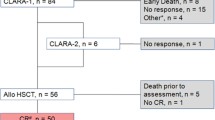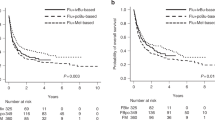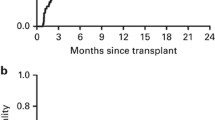Abstract
The optimal post-remission therapy (PRT) for acute myeloid leukemia (AML) remains uncertain. We reported 32 AML patients in first complete remission (CR1) undergoing autologous hematopoietic stem cell transplantation (ASCT) with a characteristic conditioning regimen, termed I-Bu, based on high-dose idarubicin plus busulfan, which considerably strengthened antileukemic activity. Most patients were in better or intermediate-risk group except that cytogenetic or molecular risk information was missing for 18.7 % of the patients. Unpurged peripheral blood stem cells were used in all the cases. The adverse effects were mild and reversible. Only one case of transplant-related mortality was observed. All the patients in this study acquired hematopoietic reconstitution after ASCT. After a median follow-up of 30 (6–119) months, 24 patients (75.0 %) were alive in which 20 (62.5 %) patients were in continuous CR. There were 11 (34.4 %) patients who relapsed after HSCT. Cumulative relapse probability was about 40 % after 24 months. Median OS and DFS have not been reached. Patients in the better and intermediate-risk group had different clinical outcomes, but the differences were not statistically significant. ASCT with I-Bu regimen is possibly promising PRT for better and intermediate-risk AML patients in CR1.



Similar content being viewed by others
References
O’donnell MR, Abboud CN, Altman J, et al. Acute myeloid leukemia. J Natl Compr Canc Netw. 2012;10:984–1021.
Gupta V, Tallman MS, Weisdorf DJ. Allogeneic hematopoietic cell transplantation for adults with acute myeloid leukemia: myths, controversies, and unknowns. Blood. 2011;117:2307–18.
Keating A, Dasilva G, Perez WS, et al. Autologous blood cell transplantation versus HLA-identical sibling transplantation for acute myeloid leukemia in first complete remission: a registry study from the Center for International Blood and Marrow Transplantation Research. Haematologica. 2013;98:185–92.
Burnett AK, Goldstone AH, Stevens RM, et al. Randomised comparison of addition of autologous bone-marrow transplantation to intensive chemotherapy for acute myeloid leukaemia in first remission: results of MRC AML 10 trial. UK Medical Research Council Adult and Children’s Leukaemia Working Parties. Lancet. 1998;351:700–8.
Mollee P, Gupta V, Song K, et al. Long-term outcome after intensive therapy with etoposide, melphalan, total body irradiation and autotransplant for acute myeloid leukemia. Bone Marrow Transplant. 2004;33:1201–8.
Suciu S, Mandelli F, De Witte T, et al. Allogeneic compared with autologous stem cell transplantation in the treatment of patients younger than 46 years with acute myeloid leukemia (AML) in first complete remission (CR1): an intention-to-treat analysis of the EORTC/GIMEMAAML-10 trial. Blood. 2003;102:1232–40.
Guieze R, Cornillet-Lefebvre P, Lioure B, et al. Role of autologous hematopoietic stem cell transplantation according to the NPM1/FLT3-ITD molecular status for cytogenetically normal AML patients: a GOELAMS study. Am J Hematol. 2012;87:1052–6.
Majhail NS, Bajorunaite R, Lazarus HM, et al. High probability of long-term survival in 2-year survivors of autologous hematopoietic cell transplantation for AML in first or second CR. Bone Marrow Transplant. 2011;46:385–92.
Vellenga E, Van Putten W, Ossenkoppele GJ, et al. Autologous peripheral blood stem cell transplantation for acute myeloid leukemia. Blood. 2011;118:6037–42.
Wang J, Ouyang J, Zhou R, et al. Autologous hematopoietic stem cell transplantation for acute myeloid leukemia in first complete remission: a meta-analysis of randomized trials. Acta Haematol. 2010;124:61–71.
Breems DA, Boogaerts MA, Dekker AW, et al. Autologous bone marrow transplantation as consolidation therapy in the treatment of adult patients under 60 years with acute myeloid leukaemia in first complete remission: a prospective randomized Dutch-Belgian Haemato-Oncology Co-operative Group (HOVON) and Swiss Group for Clinical Cancer Research (SAKK) trial. Br J Haematol. 2005;128:59–65.
Gorin NC, Labopin M, Frassoni F, et al. Identical outcome after autologous or allogeneic genoidentical hematopoietic stem-cell transplantation in first remission of acute myelocytic leukemia carrying inversion 16 or t(8;21): a retrospective study from the European Cooperative Group for Blood and Marrow Transplantation. J Clin Oncol. 2008;26:3183–8.
Linker CA. Autologous stem cell transplantation for acute myeloid leukemia. Bone Marrow Transplant. 2003;31:731–8.
Linker CA, Ries CA, Damon LE, et al. Autologous stem cell transplantation for acute myeloid leukemia in first remission. Biol Blood Marrow Transplant. 2000;6:50–7.
Buccisano F, Maurillo L, Spagnoli A, et al. Cytogenetic and molecular diagnostic characterization combined to postconsolidation minimal residual disease assessment by flow cytometry improves risk stratification in adult acute myeloid leukemia. Blood. 2010;116:2295–303.
Ferrara F, Annunziata M, Schiavone EM, et al. High-dose idarubicin and busulphan as conditioning for autologous stem cell transplantation in acute myeloid leukemia: a feasibility study. Hematol J. 2001;2:214–9.
Ferrara F, Izzo T, Criscuolo C, et al. Favorable outcome in patients with acute myelogenous leukemia with the nucleophosmin gene mutation autografted after conditioning with high-dose continuous infusion of idarubicin and busulfan. Biol Blood Marrow Transplant. 2010;16:1018–24.
Ferrara F, Palmieri S, Annunziata M, et al. Continuous infusion idarubicin and oral busulfan as conditioning for patients with acute myeloid leukemia aged over 60 years undergoing autologous stem cell transplantation. Bone Marrow Transplant. 2004;34:573–6.
Ferrara F, Palmieri S, Pedata M, et al. Autologous stem cell transplantation for elderly patients with acute myeloid leukaemia conditioned with continuous infusion idarubicin and busulphan. Hematol Oncol. 2009;27:40–5.
Yin CC, Medeiros LJ, Bueso-Ramos CE. Recent advances in the diagnosis and classification of myeloid neoplasms–comments on the 2008 WHO classification. Int J Lab Hematol. 2010;32:461–76.
Berman E, Heller G, Santorsa J, et al. Results of a randomized trial comparing idarubicin and cytosine arabinoside with daunorubicin and cytosine arabinoside in adult patients with newly diagnosed acute myelogenous leukemia. Blood. 1991;77:1666–74.
Qian SX, Li JY, Tian T, et al. Effect of low-dose cytarabine and aclarubicin in combination with granulocyte colony-stimulating factor priming (CAG regimen) on the outcome of elderly patients with acute myeloid leukemia. Leuk Res. 2007;31:1383–8.
Burnett A, Wetzler M, Lowenberg B. Therapeutic advances in acute myeloid leukemia. J Clin Oncol. 2011;29:487–94.
Buchner T, Berdel WE, Schoch C, et al. Double induction containing either two courses or one course of high-dose cytarabine plus mitoxantrone and postremission therapy by either autologous stem-cell transplantation or by prolonged maintenance for acute myeloid leukemia. J Clin Oncol. 2006;24:2480–9.
Jung AS, Holman PR, Castro JE, et al. Autologous hematopoietic stem cell transplantation as an intensive consolidation therapy for adult patients in remission from acute myelogenous leukemia. Biol Blood Marrow Transplant. 2009;15:1306–13.
Singh H, Werner LL, Asali S, et al. Comparison of autologous stem cell transplantation versus consolidation chemotherapy for patients with cytogenetically normal acute myeloid leukemia (CN-AML) and FLT3ITD. Am J Hematol. 2011;86:625–7.
Tallman MS, Perez WS, Lazarus HM, et al. Pretransplantation consolidation chemotherapy decreases leukemia relapse after autologous blood and bone marrow transplants for acute myelogenous leukemia in first remission. Biol Blood Marrow Transplant. 2006;12:204–16.
Zittoun RA, Mandelli F, Willemze R, et al. Autologous or allogeneic bone marrow transplantation compared with intensive chemotherapy in acute myelogenous leukemia. European Organization for Research and Treatment of Cancer (EORTC) and the Gruppo Italiano Malattie Ematologiche Maligne dell’Adulto (GIMEMA) Leukemia Cooperative Groups. N Engl J Med. 1995;332:217–23.
Dohner H, Estey EH, Amadori S, et al. Diagnosis and management of acute myeloid leukemia in adults: recommendations from an international expert panel, on behalf of the European LeukemiaNet. Blood. 2010;115:453–74.
Koreth J, Schlenk R, Kopecky KJ, et al. Allogeneic stem cell transplantation for acute myeloid leukemia in first complete remission: systematic review and meta-analysis of prospective clinical trials. JAMA. 2009;301:2349–61.
Pfirrmann M, Ehninger G, Thiede C, et al. Prediction of post-remission survival in acute myeloid leukaemia: a post hoc analysis of the AML96 trial. Lancet Oncol. 2012;13:207–14.
Acknowledgments
This study was supported by the National Natural Science Foundation of China (81200362, 81070456 and 81270652), the Program for Development of Innovative Research Team in the First Affiliated Hospital of NJMU, the Project Funded by the Priority Academic Program Development of Jiangsu Higher Education Institutions and the Project of the National Key Clinical Specialty.
Conflict of interest
The authors have declared no conflict of interest.
Author information
Authors and Affiliations
Corresponding authors
Rights and permissions
About this article
Cite this article
Hong, M., Miao, KR., Zhang, R. et al. High-dose idarubicin plus busulfan as conditioning regimen to autologous stem cell transplantation: Promising post-remission therapy for acute myeloid leukemia in first complete remission?. Med Oncol 31, 980 (2014). https://doi.org/10.1007/s12032-014-0980-x
Received:
Accepted:
Published:
DOI: https://doi.org/10.1007/s12032-014-0980-x




